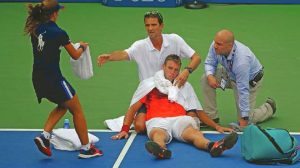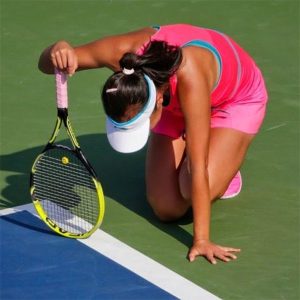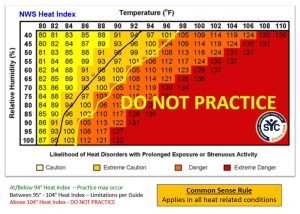By Karen Ronney
While tennis is a favorite sport for many Southern California Tennis Association Foundation fans, it is important to proceed with caution in extreme heat. In this article, you will learn the Top 10 Tips to survive playing tennis in the heat from the @socaltennisassocfoundation. Also how to recognize heat exhaustion or heatstroke and effective recovery actions.
“Our goal is to promote the growth of tennis with safety and wellness,” said Linda Milan, the Executive Director for the Southern California Tennis Association Foundation. “We want everyone to enjoy playing tennis while staying healthy. We think educating our So Cal community tennis members is a big first step.” 
Normal body temperature is around 98.6 degrees Fahrenheit but it can vary between 97 and 99 degrees.
“Your body temperature can increase about a degree for every five minutes of exercise you’re doing,” says Joshua Scott, MD, primary care sports medicine physician at Cedars-Sinai Kerlan-Jobe Institute. “Sweat is the main way your body cools itself down. But in humid and hot environments, sweat doesn’t evaporate as quickly, which can cause you to overheat. Add high temperatures and exercise to the mix, and you can easily overheat before you know it.” (Article excerpt from Insiders.com 7/6/22)
Top 10 Tips from the Southern California Tennis Association Foundation
- Stay Hydrated: The biggest concern for exercising in the heat is dehydration, which is when an athlete loses more fluid that he/she drinks. The body can’t function properly which leads to fatigue.
- Replace Electrolytes During Exercise: Electrolytes are minerals that have an electric charge such as sodium, potassium, calcium, bicarbonate, magnesium, chloride and phosphate. Many bodily functions depend on these including muscles, nerves and regulating blood pressure. Electrolytes also play a role in hydration and pH balance. Good choices are coconut water, Propel, fruit juice, Pedialyte, pickle juice, fruit and vegetable smoothies, Gatorade, and V8 juice. Avoid caffeine and energy drinks, as they can have adverse affects on the body.
- Wear Protective Gear: It helps to wear hats, visors and sunglasses. This keeps your head cool and can protect your eyes from UV damage. Also apply sunscreen liberally and often.

- Select Light Colored Clothing: Wearing white or light colored sportswear will help reflect the heat instead of absorbing it. Avoid wearing dark colors. Also, select dry fit fabrics because they are lighter and more comfortable.
- Build Heat Endurance: Physical exertion and training activities should begin slowly and increase progressively. It can take up to a few months to build up conditioning in the heat. Start with shorter less intense practice sessions and longer recovery intervals in between. Keep each player’s individual health in mind and adjust accordingly.
- Combine Conditioning Within Practices: Gradually build in fitness and footwork during drills, games and activities. Don’t have all conditioning scheduled for the beginning or end of practices.
- Increase rest breaks with higher heat: Be aware of the temperature. If the So Cal heat is in the 90 degrees or higher, be cautious. Keep in mind it could be 5 to 10 degrees hotter on a tennis court.
- Hydrate Before, During and After Matches: Gradually building up your fluids before, during and after matches is a better choice than drinking too much at one time. Also check the color of urine. It should be pale or the color of lemonade. If it is dark like apple juice, the athlete is dehydrated.
- Recognize the signs of heat illness: Look for noticeable thirst, irritability, headache, goosebumps, weakness, dizziness, muscle cramps, chills, nausea and vomiting, heat sensations in the head and neck, and decreased performance.
- Take Immediate and Proper Action If Heat Illness Happens: If any of the above symptoms are present, immediately stop exercise. Try to cool the body down with cold wet towels or bags of ice on the head, neck, arm pits, underside of wrists and groin areas.
 Overview:
Overview:
Recognize Early Signs of Distress: Understanding the symptoms of heat exhaustion or heatstroke can avoid serious health problems. Look for deterioration in performance, signs of struggling, bending over with hands on knees, dizziness, headache and bright red flushing of the skin. If this happens, STOP IMMEDIATELY and get to the shade. Have the player lay down comfortably. And sip a water and/or a sports drink. Apply ice bags or cold towels on the areas in Tip No. 10. Immediate cooling is the most important step to reduce the risk of injury, disability or death. If a rapid improvement is not seen within a few minutes, call 911 for medical intervention. Remember in the event of a heat stroke, every second counts.
###
About Southern California Tennis Association Foundation – Founded in 1986, the Southern California Tennis Association Foundation is a 501c3 nonprofit organization and is the charitable arm of USTA Southern California. The Foundation’s mission is to “Change lives and build communities through tennis.” Since 2020, the SCTA Foundation has had a community impact of giving over $600,000 in tennis grants and tennis scholarships to deserving youth, adults, tennis organizations, tennis facilities and tennis programs to make tennis an equal opportunity sport, accessible to all, regardless of age, ability, ethnicity, or economic background. Visit us on Social Media on Instagram, Facebook and Twitter. To learn more about the SCTA Foundation go to: www.sctafoundation.org. To donate go to: sctafoundation.org/donate/. https://secure.qgiv.com/for/sctfougivtue


